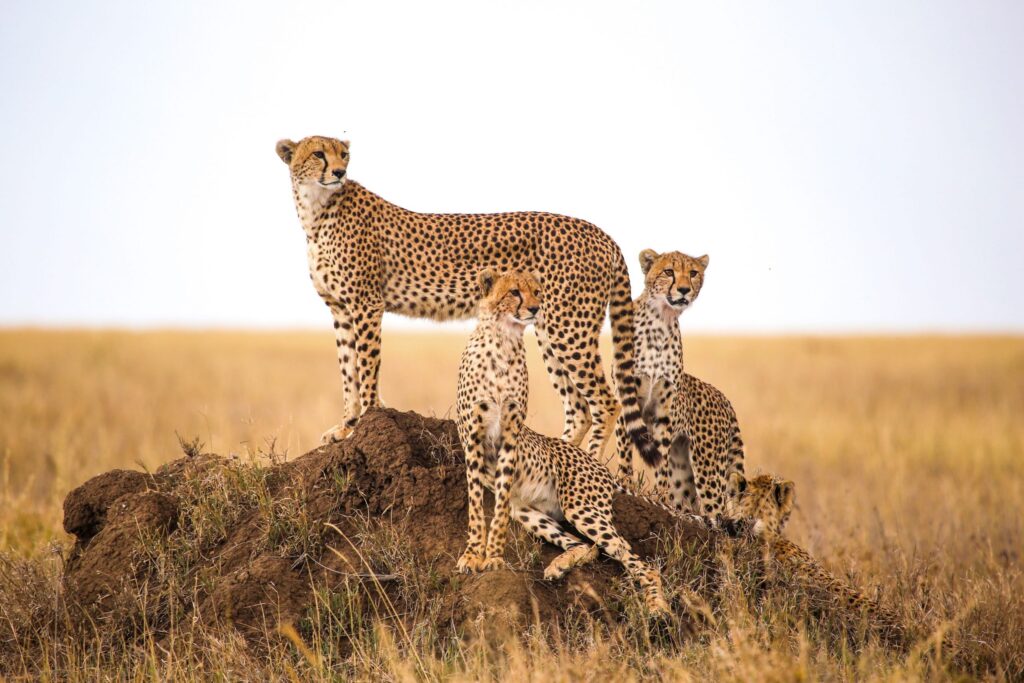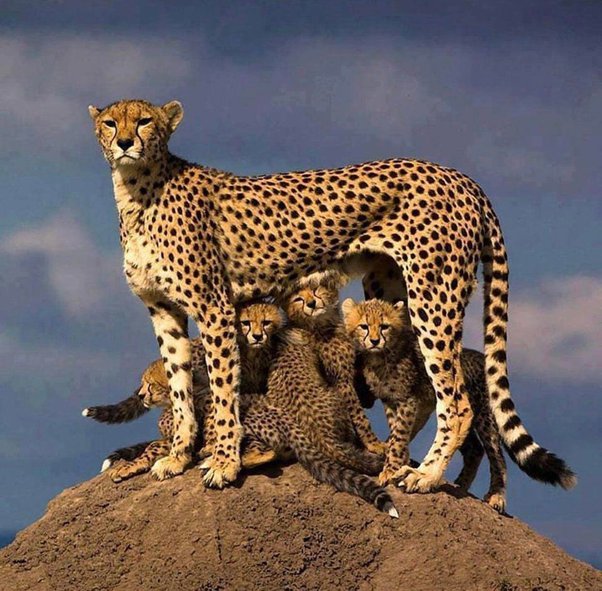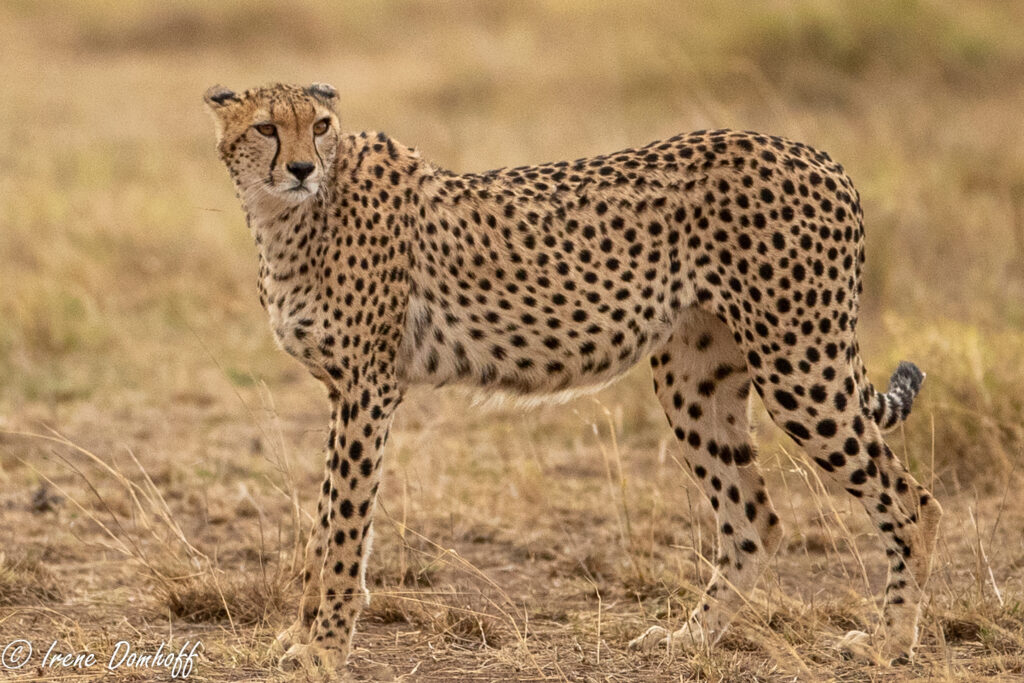”From Spotted Cubs to Agile Hunters: A Journey into the Cheetah’s World”
INTRODUCTION:
The cheetah, with its distinctive spotted coat and unmatched speed, embarks on a remarkable journey from adorable spotted cubs to sleek and agile hunters. In this topic, we delve into the fascinating world of cheetahs, renowned as the fastest land animals on Earth, possess a unique set of adaptations and hunting strategies.
This topic explores the remarkable physical attributes and behavioral traits of cheetahs that contribute to their exceptional speed and hunting prowess. By delving into the intricacies of their adaptations, we gain insight into the evolutionary success of these fascinating big cats.

Cheetah subspecies:
The classification of cheetah subspecies has been a topic of ongoing research and discussion among scientists. Currently, there is some variation in the recognized subspecies of cheetahs. Here are some commonly mentioned cheetah subspecies:
- Acinonyx jubatus jubatus: South African Cheetah or Southern Cheetah. Found in southern Africa, including countries like South Africa, Namibia, Botswana, and Zimbabwe.
- Acinonyx jubatus raineyi: East African Cheetah or Kenyan Cheetah. Historically found in East Africa, including Kenya, Tanzania, Somalia, and Uganda.
- Acinonyx jubatus venaticus: Asiatic Cheetah or Iranian Cheetah. Critically endangered and found primarily in Iran, with rare sightings in neighboring countries like Afghanistan and Pakistan.
- Acinonyx jubatus soemmeringii: Northwest African Cheetah or Saharan Cheetah. Inhabits parts of the Sahara Desert and the Sahel region in countries such as Algeria, Niger, Mali, and Chad.

Adaptations and Hunting Strategies of Cheetahs:
Speed as a Signature Trait:
Cheetahs are celebrated for their incredible speed, capable of reaching speeds of up to 60 to 70 miles per hour (97 to 113 kilometers per hour) in short bursts. Their streamlined body shape, long limbs, and flexible spine are specialized adaptations designed for swift acceleration and agile maneuvering during high-speed pursuits.
Musculoskeletal Adaptations:
Cheetahs possess a lightweight skeleton, reduced clavicle, and fusion of certain limb bones, which contribute to their efficient stride and increased stride length. Their non-retractable claws provide traction, acting like cleats, while their highly developed leg muscles generate explosive power.
Aerodynamic Design:
The cheetah’s body exhibits aerodynamic features, including a slim frame, elongated body, and a long tail that acts as a rudder for balance and course correction during high-speed chases. These adaptations minimize air resistance and enable the cheetah to maintain stability while running at astonishing velocities.
Keen Senses and Vision:
Cheetahs possess acute eyesight, allowing them to spot prey from great distances. Their large nasal passages and enlarged adrenal glands enhance oxygen intake and facilitate rapid adrenaline release, crucial for sustained bursts of speed during hunts.
Hunting Techniques:
Cheetahs employ a combination of stealth, patience, and explosive bursts of speed to secure their prey. They rely on a stalking technique, cautiously approaching their target, and when within range, initiate a rapid acceleration, sprinting towards the prey with astounding speed. Their success rate heavily relies on catching their prey off guard and outpacing them in short, intense bursts.
Unique Challenges:
Despite their remarkable adaptations, cheetahs face challenges such as competition from larger predators like lions and hyenas, limited stamina for prolonged chases, and the need to recover after high-speed sprints, which can render them vulnerable to scavengers and other threats.
Conservation and Future Outlook:
Understanding the adaptations and hunting strategies of cheetahs is crucial for their conservation. Habitat loss, human-wildlife conflicts, and illegal wildlife trade pose significant threats to their survival. Conservation efforts focus on preserving their natural habitats, addressing human-wildlife conflicts, and promoting sustainable practices to secure a future for these majestic creatures.

Global population of cheetahs:
The current wild population of cheetahs is estimated to be between 6,517 to 7,000 in the world, while Asian cheetahs are believed to number less than 50 (2023).
Cheetahs population in india 2023:
There are currently 20 cheetahs in India in 2023 in Kuno National Park in Madhya Pradesh. On 17 September 2022, a total of eight cheetahs, consisting of five females and three males from Namibia, arrived at Kuno National Park in Madhya Pradesh, India, and were released as part of the reintroduction program.
Date of project cheetah launch in India: 17 september2022
On 17 September 2022 prime Minister Narendra Modi released the first group of African cheetahs into Kuno National Park (Madhya pradesh).
“Project Cheetahs” initiative, which began in India in 2009.
On 18 February 2023, a second batch of cheetahs landed in India.
Project cheetah in india:
- Project Cheetah is recognized as the world’s first intercontinental large wild carnivore translocation initiative, which aims to introduce cheetahs to India. Project Cheetah is an initiative undertaken by the Indian government to reintroduce cheetahs to the country, which were declared extinct in India in 1952.
- The project aims to establish a viable and secure cheetah population in India by creating a conducive environment for the species, conserving their habitats, and promoting knowledge exchange and capacity building.
- This project under International Union for Conservation of Nature (IUCN) guidelines to ensure that the reintroduction is done in a sustainable and environmentally responsible manner.
- It also aims to reintroduce the Asiatic cheetah, a sub-species of the cheetah that is found in Iran, into India. (Acinonyx jubatus venaticus)
Cheetahs are in the “vulnerable” category of threatened species, with a population decline of approximately 50% over the past four decades and a significant reduction in their historical range.
